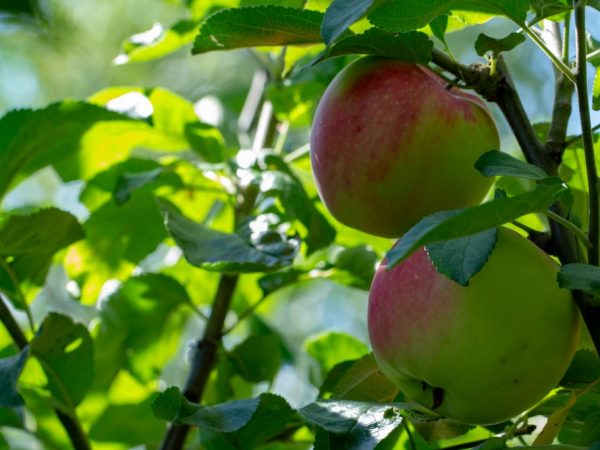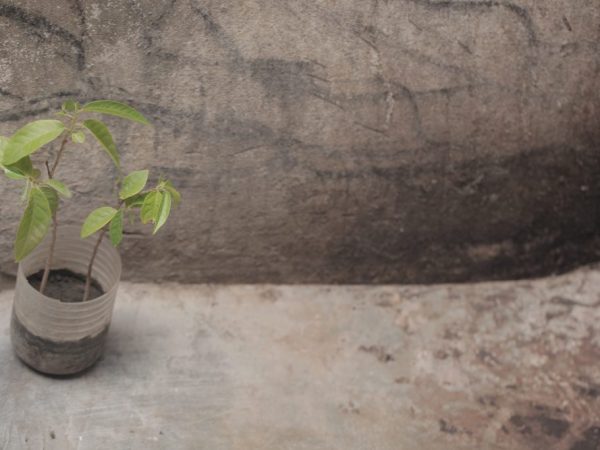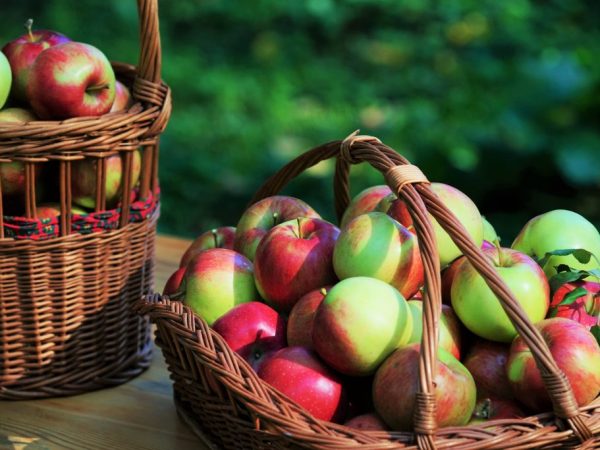Description of Bayan's apple tree
Growing and getting a large harvest of apples in risky farming zones is problematic even for an experienced gardener. Bayana's apple tree is one of the best large-fruited varieties, which was bred by breeders in 1984 specifically for cultivation in the Urals and Siberia. Bellefleur-Chinese, Altai purple and Gorno-Altai were taken as a basis.

Description of Bayan's apple tree
General description of the variety
This culture is of autumn ripening, it has an average height - the height of an adult tree reaches 4-4.5 m. The crown is in the form of a broom, weakly branched, the circumference is 3-4 m. The stems are straight, extend from the trunk at a slight angle. The annual growth of vertical shoots is about 8-10 cm, horizontal ones - 6-7 cm.
Compared to other varieties grown in Siberia and the Urals, the fruits are large - their weight is 90-115 g. Some specimens reach 150 g.
Apples are yellow-green in color with a large blush, dense, thick-skinned, with a waxy coating. The shape is rounded, slightly flattened, the surface is slightly ribbed. When fully ripe, the fruits take on a rich purple color.
The pulp is firm, juicy, sweet, white or creamy.
Attractive fruits with a sweet and sour taste were scored 4.7 points on a 5-point scale.
Advantages and disadvantages of the variety
The description of the Bayana variety includes several advantages.
- Good yield. In the early years, the culture bears fruit poorly, but every year the indicators are improving. Trees 7 or 8 years old give about 80 kg of fruit. Up to 14 tons of fruit can be harvested from 1 hectare.
- Early ripeness - the fruits begin to be removed already in 3-4 years of cultivation.
- This crop is capable of producing good yields every year. Violation of productivity indicators downward is possible only with aggravation of weather conditions - frequent rains and sharp temperature changes in the spring-summer period.
- Increased winter hardiness and frost resistance. Trees endure long wintering with severe frosts - down to -35 ° С. They will be able to successfully survive even stronger, but short-term frosts. Despite the good cold resistance, gardeners prefer to cover trees for the winter.
- The plant is highly immune to powdery mildew and scab.
- It is a self-fertile crop pollinated by bees. But to improve the quality and quantity of the harvest, gardeners recommend planting several winter varieties nearby, which bloom simultaneously with this tree. The best pollinators are Gornoaltaiskoe, Siberian Souvenir, Melba, Papirovka or Grushovka.
The Bayan apple tree has several disadvantages:
- often affected by black, European crayfish, lichens, prone to drying out of the bark and branches;
- in the process of ripening, there is a significant shedding of fruits;
- poor harvest in the early years of fruiting.
Landing rules
You can plant seedlings of this variety both in spring and autumn.Gardeners who have been growing this culture for several years prefer spring planting. During the summer, the roots of the plant have time to get stronger, to adapt in the soil, which increases the resistance of young trees to freezing.
Site preparation

Choose a sunny place to plant a seedling
For Bayan apple trees, a sunny place with protection from the winds is suitable. Choose a loamy soil with good drainage. In order to avoid root rot, it is important that the groundwater is at a depth of at least 2.5 m.
The plot is harvested in the fall - sprinkled with a bucket of compost or manure, add 3 kg of ash and 100 g of potassium nitrate and superphosphate. The soil is dug up and leveled.
In the spring, as soon as the spring frosts pass and the soil warms up to 10-12 ° C, they begin to prepare the planting holes.
Holes up to 70 cm deep and 80 cm wide are dug out, drainage from stones is laid on the bottom. The dug earth is mixed with 2 buckets of humus. Add 60 g each of potassium nitrate and superphosphate. The hole is filled halfway with the nutrient composition, then sprinkled with a thin layer of soil without fertilizer.
Technology
Two weeks after the preparation of the pits, seedlings are planted. For better survival, the roots are trimmed a little - 3-4 cm in length, then dipped in a clay chatterbox for an hour.
The roots are lowered into a hole, straightened and sprinkled with garden soil without fertilizers. The tree is planted so that the root collar remains not buried, otherwise the risk of rotting is inevitable.
At a distance of 50 cm from the trunk, holes are pulled out in diameter and poured with water. When watering for the first time, 10 liters of water is enough. To avoid the rapid drying out of the soil, the tree is covered with earth.
When planting in groups, it is important to follow the 4x5 m scheme. So the apple trees will receive the required amount of light, fully develop and bear fruit abundantly.
Care
Watering
For the successful growth of the aboveground and underground parts, young trees need to be watered frequently.
In the absence of precipitation, the frequency of watering is once every 10 days. The amount of water is at least 10 liters.
Moistening of adult apple trees (from 5 years old) is carried out according to a certain scheme: the first procedure is carried out in early spring, then a week before flowering and 2 weeks after it.
Then the apple tree is moistened during the period of pouring the fruits and in late autumn - a month before the onset of frost.
Loosening
After each watering, the soil is loosened, then mulched with humus, peat or ordinary garden soil. This will help keep it moisture and breathable.
Top dressing
According to the description of the apple tree, the Bayana variety responds well to fertilizers, responding with a plentiful and tasty harvest.
- The first fertilizer is applied at the 3rd year of life. In early spring, the near-stem zone is fertilized with nitrogen preparations - a solution of urea (1 tablespoon per bucket of water) or nitrophoska (prepared in accordance with the instructions).
- Before flowering and at the stage of pouring apple fruits, you can feed with superphosphate (1 tablespoon) and potassium nitrate (1 tablespoon) per 10 liters of water. These components improve the quality of flowering and fruiting.
- Before the onset of cold weather, the near-stem zone is spilled with a urea solution (1 tbsp. L. Per 10 l of water). Such fertilization increases the resistance of apple trees to cold weather and various diseases.
Additionally, in early spring, the tree can be sprayed with iron sulfate to avoid iron deficiency.
Shaping and trimming

The yield of the variety depends on the correct care.
- The first pruning of seedlings is carried out immediately after planting - the central conductor is shortened by 15 cm from the top.
- The next year, the lateral shoots and the central branch are pruned by a third of the length. In the first order, the 3 strongest shoots are left, the remaining branches are cut into a ring.
- In the third year, a second row of the two thickest branches is formed.
- All subsequent years they carry out a sanitary shearing of shrunken branches, broken off by the wind and affected by diseases.
To avoid infection, the cut sites are sprayed with copper sulfate, then treated with garden varnish.
At 7 or 8 years of age, when the tree ceases to give young growth, rejuvenating pruning is carried out - all five-year-old branches are cut into a ring, and young ones - by a third of the length.
Preparation for wintering
The procedure consists in processing the trunks with slaked lime, hilling the near-trunk zone and covering with spruce branches or roofing material. In a snowy winter, the tree can be sprinkled with a snowdrift.
Ripening and fruiting
This is a fast-growing crop that begins to bear fruit in the 3rd or 4th year of cultivation. The type of fruiting is mixed.
The tree blooms in the last decade of May. The mass harvest is carried out at the end of September. Full maturity can be determined by the characteristic purple color of the fruit.
Products of this variety are characterized by long shelf life - up to 4 months in a cool place (cellar, basement or refrigerator). After this time, apples lose their original taste and marketability.
Subspecies
Many gardeners successfully grow this variety on a semi-crop seed stock. The new hybrid has unique qualities:
- forms a low-growing shrub-shrub with a height of 2 to 3 m;
- gives tasty and juicy yellow fruits with golden-burgundy stripes;
- average fruit weight - 130-150 g;
- taste is estimated at 4.7 points;
- the plant has good frost resistance - the shoots do not freeze at a temperature of -40 ° C.
The only drawback is that in the rainy season, the fruits are prone to cracking.
Growing regions
Given the harsh climatic conditions and inconsistent weather in the Urals and Siberia, certain care rules should be strictly observed when growing this crop.
- In Siberia. Despite its high frost resistance, the tree needs good shelter for the winter. The near-trunk circle is spud with a 10 cm layer of peat, and covered with fallen leaves on top. Before the shelter, in autumn, and in early spring, after its removal, the tree is whitewashed with slaked lime. This will prevent infections and sunburn on the tree.
- In the Urals, where there are frequent winds, a young tree must be tied to a support to protect it from breaking off the shoots. Supports are installed next to mature trees. To improve the quality and quantity of the crop, the application of phosphorus and potash fertilizers is required, the dosage and application rules are described above. To prevent fungal infections, trees are pruned annually in the spring.
Reviews of gardeners
The Bayan apple variety is the most widespread crop in the northern region of our country. Gardeners who grow this variety leave positive reviews - the plant tolerates wintering well and gives a consistently high yield of large fruits.
Some people note a decrease in yield in the absence of fertilizing and frequent watering, therefore, in order to obtain good productivity, it is advised to provide the tree with proper care.
Apples are in great demand among consumers, because they are very tasty fresh and are suitable for various preparations.
According to gardeners, a properly harvested crop in cool conditions can lie all winter without loss of taste and marketability.

